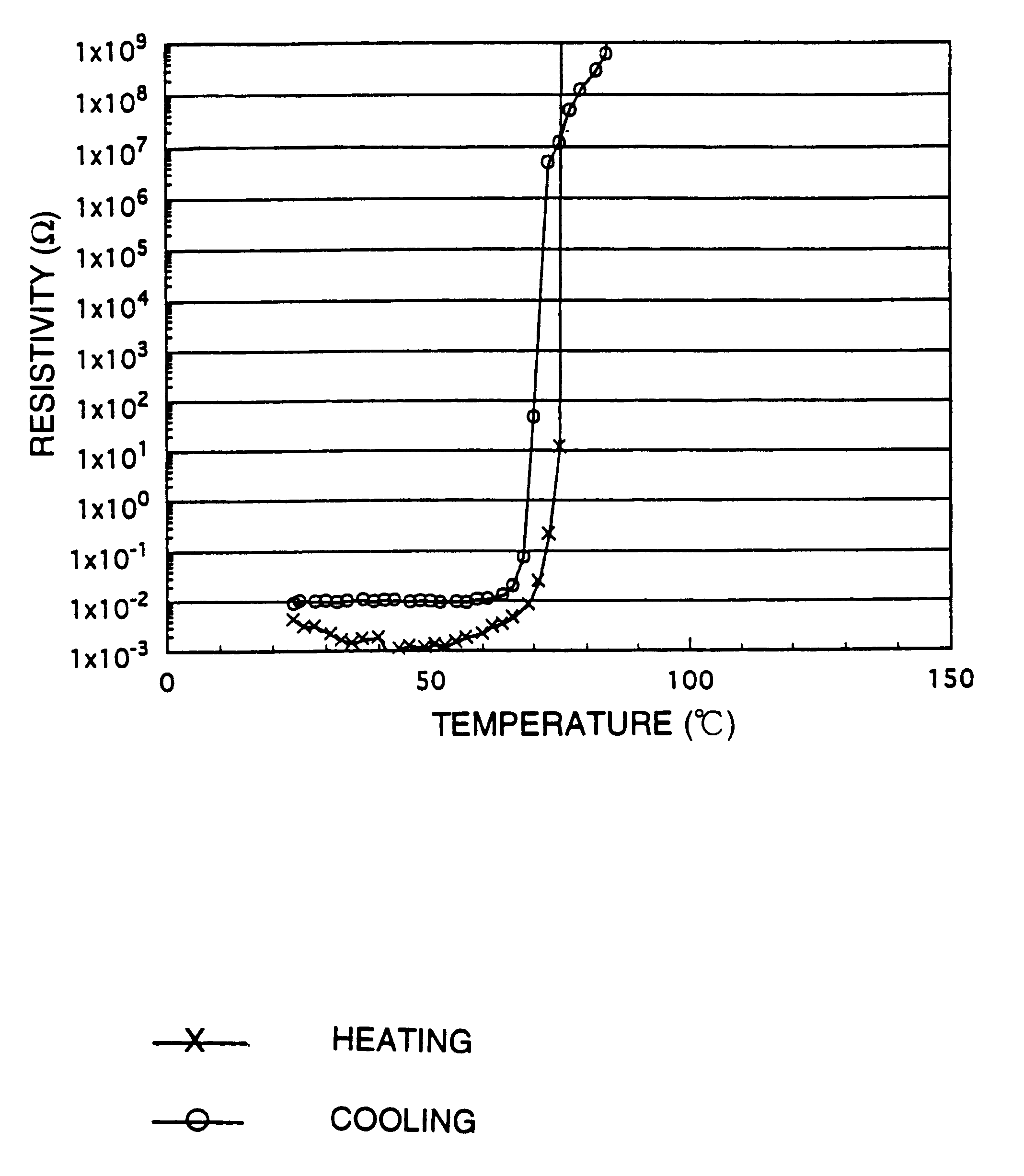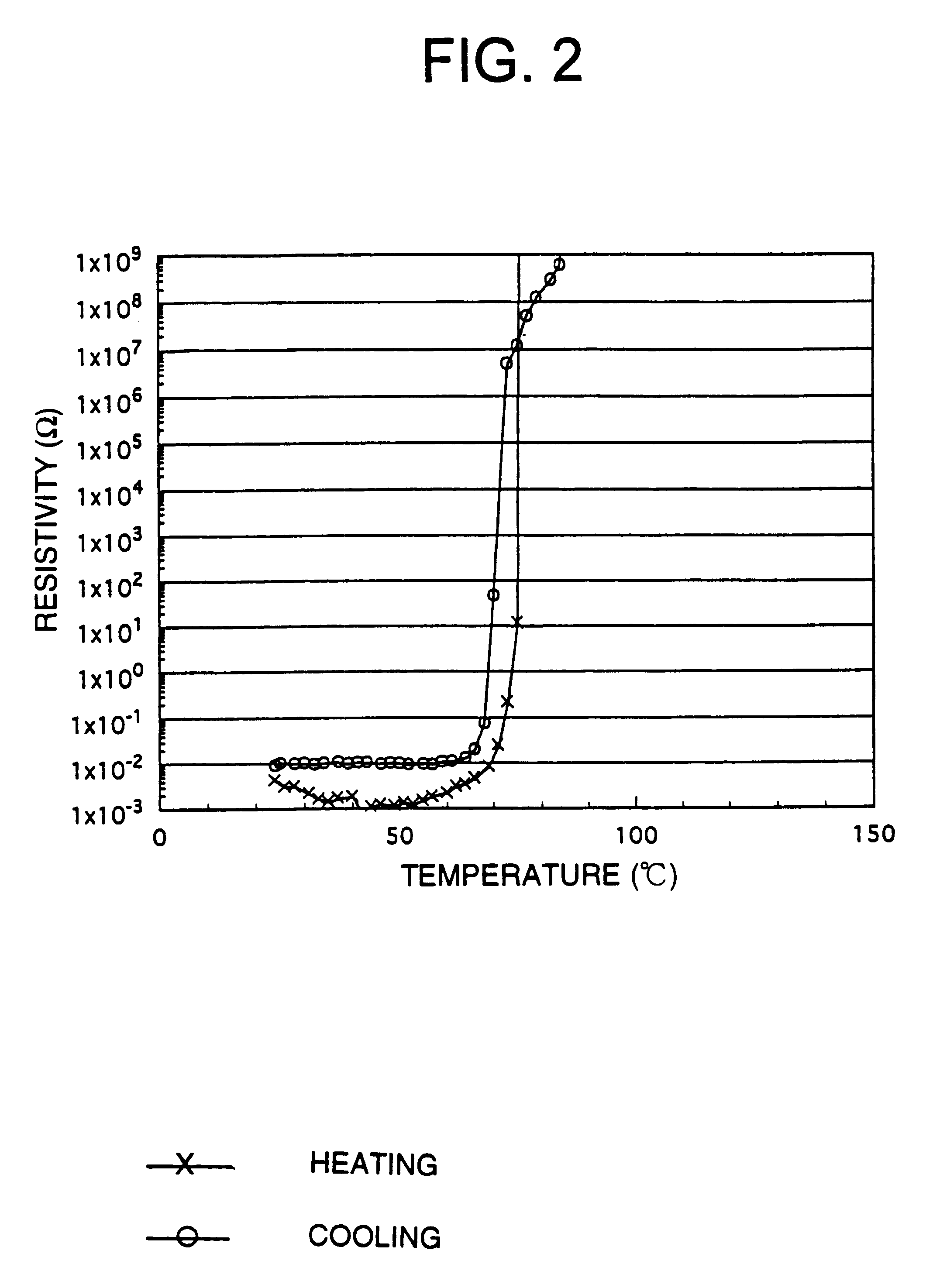Organic positive temperature coefficient thermistor
- Summary
- Abstract
- Description
- Claims
- Application Information
AI Technical Summary
Benefits of technology
Problems solved by technology
Method used
Image
Examples
example 1
Bisphenol A type epoxy resin (Epicoat 801 made by Yuka Shell Epoxy Co., Ltd.) and an modified amine type curing agent (Epomate B002 made by Yuka Shell Epoxy Co., Ltd.) were used for the thermosetting polymer matrix. Paraffin wax (HNP-10 made by Nippon Seiro Co., Ltd. with a melting point of 75.degree. C.) was used as the low-molecular organic compound and filamentary nickel powders (Type 255 Nickel Powder made by INCO Co., Ltd.) was used as the conductive particles. The conductive particles had an average particle diameter of 2.2 to 2.8 .mu.m, an apparent density of 0.5 to 0.65 g / cm.sup.3, and a specific surface area of 0.68 m.sup.2 / g.
Twenty (20) grams of bisphenol A type epoxy resin, 10 grams of the modified amine type curing agent, 15 grams of paraffin wax (0.5 times as large as the total weight of the epoxy resin and curing agent), 180 grams of nickel powders (4 times as large as the total weight of the organic components) and 20 ml of toluene were mixed together in a centrifuga...
example 2
Unsaturated polyester resin (G-110AL made by Nippon Shokubai Co., Ltd.) was used as the thermosetting polymer matrix, benzoyl peroxide (Kadox B-75W made by Kayaku Akuzo Co., Ltd.) as the organic peroxide, behenic acid (made by Nippon Seika Co., Ltd. with a melting point of 81.degree. C.) as the low-molecular organic compound, and the same filamentary nickel powders (Type 255 Nickel Powder made by INCO Co., Ltd.) as in Example 1 as conductive particles.
Thirty (30) grams of the unsaturated polyester resin, 0.3 grams of benzoyl peroxide, 15 grams of behenic acid, 180 grams of the nickel powders and 20 ml of toluene were mixed together in a centrifugal disperser for about 10 minutes. The obtained paint-like mixture was coated on one side of one 30 .mu.m thick Ni foil electrode, and another Ni foil electrode was placed on the coated mixture. The sheet-like assembly was sandwiched between brass plates using a spacer to a total thickness of 1 mm. This was thermally cured at 80.degree. C. f...
example 3
A thermistor element was prepared as in Example 1 with the exception that curing was carried out at 150.degree. C. for 1 hour and at 180.degree. C. for 3 hours using 20 grams of polyaminobis-maleimide prepolymer (Kerimide B601 made by Ciba-Geigy) and 10 grams of dimethylformamide for the thermosetting polymer matrix in place of bisphenol A type epoxy resin and the modified amine type curing agent. By estimation, the thermistor element was found to be equivalent to the thermistor element obtained in Example 1.
PUM
 Login to View More
Login to View More Abstract
Description
Claims
Application Information
 Login to View More
Login to View More - R&D
- Intellectual Property
- Life Sciences
- Materials
- Tech Scout
- Unparalleled Data Quality
- Higher Quality Content
- 60% Fewer Hallucinations
Browse by: Latest US Patents, China's latest patents, Technical Efficacy Thesaurus, Application Domain, Technology Topic, Popular Technical Reports.
© 2025 PatSnap. All rights reserved.Legal|Privacy policy|Modern Slavery Act Transparency Statement|Sitemap|About US| Contact US: help@patsnap.com



